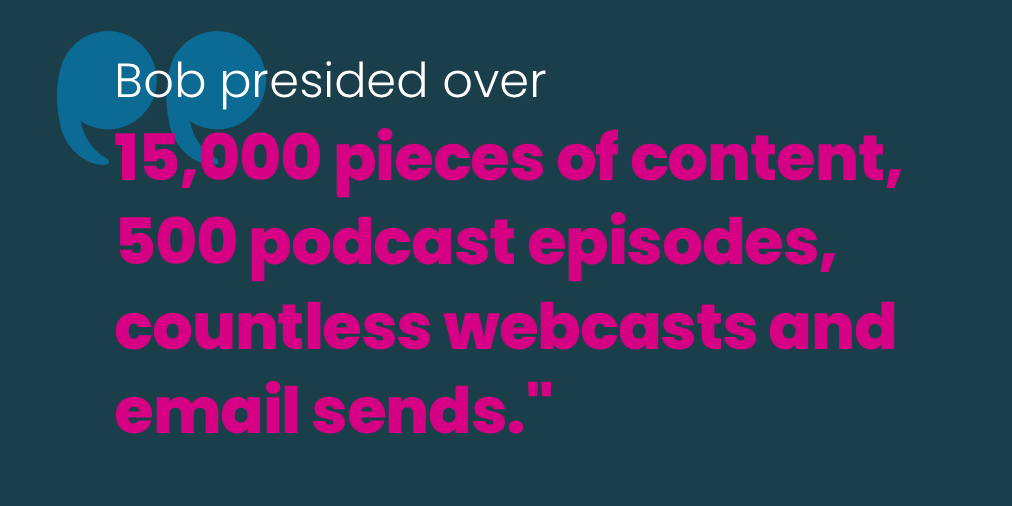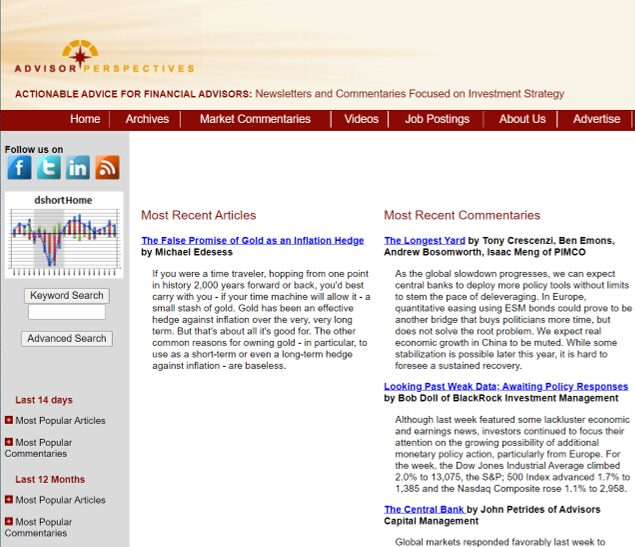
After 17 years of ‘advancing the conversation,’ Huebscher bids farewell to Advisor Perspectives
A chapter closes today when Bob Huebscher signs off from Advisor Perspectives, the ground-breaking publication he founded 17 years ago.
AP was established at a time when consumer and trade publishing was being disrupted by web 2.0 trends and technologies that enabled users to generate content alongside brands and publishers. In the wake of the Great Financial Crisis, as financial advisors sought to step out and build their own personal brands, it was Advisor Perspectives that uniquely provided them a platform. AP gave equal prominence to advisors’ and asset managers’ views, extending their reach to an increasingly online advisor community.

Bob Huebscher
In his role, Bob presided over 15,000 pieces of content, 500 podcast episodes, countless webcasts and email sends. Dan Solin, Beverly Flaxington, Sara Grillo, Christine Simone and Michael Kitces were among the advisors whose profiles AP helped elevate over the years. According to research conducted annually by Erdos Media Research, Advisor Perspectives’ email newsletter has been the most read by advisors for five consecutive years.
Last week Lowe Group Founder and President Jody Lowe and Head of LG Digital Pat Allen asked Bob to reflect on what he built. To the Q&A Jody brought a PR perspective, with Lowe Group clients having been among the several hundred authors whose works were published over the years. Pat’s focus was on the opportunity AP offered to an ever–growing list of asset manager advertisers and sponsors. While today AP has several content properties, at its core was its high performing email list (the engagement a reflection of AP’s content quality standards) and its website.
Jody: How did it all begin, Bob?
Bob: My original idea was to offer an exclusive database of high and ultra-high net worth investor asset allocations. I wrote a newsletter to highlight certain aspects of that data, and I realized very quickly that there was much more interest in the newsletter than there was in the actual data. Within six months, we pivoted and focused exclusively on the newsletter.
That was at a time when all of the competition was still legacy print-based. I was really the first-all digital publication, and I saw all the advantages that we could offer to advertisers in a digital world.
So, we did very well. The real boom for us was with the 2020 pandemic because, even though by then everyone had a digital version of their publication, our competition was still very reliant on print and in-person events, and both of those went to zero. From the start of the pandemic through the next two years, we grew at an enormous rate.
Pat: It was a genius move—to build a business based on user-generated content, wasn’t it?
Bob: No, no. But I’ve never really employed any writers. I have cultivated a group of freelance writers who write for me, and I generally use one of their articles per week, and then I write occasionally myself. We quickly became recognized as an authoritative source
There are lots of people in the advisory and asset manager world who write something and want to get it read by the biggest possible audience. They’re not interested in getting paid for it necessarily.
Over time, I probably accept 60% to 70% of what’s submitted. My criteria is that it has to advance the conversation. It’s got to have something that’s going to tell our audience something they likely don’t already know.
“There are lots of people in the advisory and asset manager world who write something and want to get it read by the biggest possible audience.”
Pat: So, your primary business asset wasn’t an editorial team, it was your email list. How did you build it?
Bob: We did some things then that today wouldn’t be considered good email practice, but it worked for us. I had built a large database of email addresses of advisors when I was at ByAllAccounts and when I started this, I was able to license that from them. I was able to sort of bootstrap everything from that list.
We licensed some outside databases that we used to invite people in. We used to use Discovery Data and we had some other deals where we cross-promoted to grow our lists.
When AP was young, I would do deals with other publications that today they’d never be willing to do. I would go to a publication, and I’d say, “Our email list has 10,000, or 20,000, names. How about if we do a reciprocal promotion where I’ll mail your piece to my list and you mail my piece to your list?”
The email we’d provide would try to get people to subscribe to Advisor Perspectives. I was able to do that a dozen, maybe 15 times. Eventually we got so successful people wouldn’t do that with us anymore.
Jody: Can you talk a bit about how you differentiated your business model? You focused less on products and more on community, I think that was a brilliant piece of it, as well.
Bob: Ten or so years ago, we realized that there was an opportunity to build a community that sat alongside our publication. That was what eventually became APViewpoint, which was really the first and only online community for advisors.
It serves as the feedback mechanism for basically everything we publish. If there’s a comment on an article, it gets fed through APViewpoint and people can go there and see what others have written. While other publications either avoid comments or allow people to participate anonymously or it’s overridden by bots. we purposefully decided that we would authenticate everyone who joined APViewpoint and they had to participate under their real name.
So when you go there, you’ll see the names of all of the prominent thought leaders—Wade Pfau, Michael Finke, David Blanchett and Harold Evensky—and they’re all actively participating under their real names. There’s nowhere else you can go to get that type of feedback and insight.
Pat: And access.
Jody: Almost in real time, too.
Let’s pivot to some of the content topics and some of the rich content you’ve published over the years. What was some of the most memorable content or the content that got the most engagement?
Bob: There was one thing I did early on that helped put me on the map. I was willing to call anyone, and I called Jack Bogle [the late founder of Vanguard] and asked him for an interview. And, he said yes.
This was within the first couple of years. People saw that I got an interview with him and that established a lot of credibility for us. Journalism is about trust and credibility and people seeing that you’re providing good information that isn’t tainted by bias and isn’t tainted by someone who’s bending over to serve the needs of your advertisers.
"Journalism is about trust and credibility and people seeing that you're providing good information that isn't tainted by bias."
I remember we ran an article by Michael Edesess about how hedge funds destroy investor wealth. It got huge readership because it was a great title and it was a great subject line. The subject lines are what makes or breaks readership, but that was just a great article.
More recently, I wrote an article about SPACs and how SPACs were just a terrible idea. It was the first featured result on Google and for some period of time I had the most widely read article on SPACs.
A little over a year ago, [Wealth Logic RIA] Allan Roth wrote about how to build a portfolio with TIPs that could deliver a safe withdrawal rate of 4.3% for 30 years. Prior to this, the research said that it was tough to get to 4% and that was never risk-free. Allan and I talked about it, it was probably my idea originally, but Alan refined it and wrote the article. It was a groundbreaking concept for much of the advisory profession.
Jody: What were the controversial articles or topics that stand out?
Bob: The articles that have gotten us in trouble got us in trouble with product providers.
Early on I wanted to understand annuities better than I did. There was an annuity that became very popular. I tried to understand it myself and I couldn’t. So, I paid an economics PhD to understand the model. And then we had to pay a computer scientist to build a program to simulate it. The annuity provider did not take kindly to what we found and wrote about.
Jody: You were one of the first in our space to start an advisor podcast. Let’s talk about that.
Bob: You know, it’s been fun. We saw that it was a growing medium. We saw that it was something that could develop good engagement with our audience and we consistently get an average of around 400 advisors. If it’s a really good one, we can get 1,000 and sometimes we get a couple thousand.
We found it was a great way to engage with asset managers, particularly ones that were just starting out marketing and wanted to gain a little bit of exposure for themselves. Maybe they didn’t have a big marketing budget but they wanted to get a sense of how well their message would engage with our audience.
Jody: What tips do you have for PR pros on submitting content?
Bob: Here’s what I look for. Obviously, it helps if the content is coming from someone who’s got a high enough profile that I’ve heard of them before, but typically that’s not the case.
I’m looking for something that is clearly not intended to promote a product. If the pitch starts off by saying, “Our fund just produced 10% returns in the last month and we’ve grown assets by X number of billions of dollars,” I can see right away that this is an attempt to promote a product. That’s an immediate turn-off.
Second, is there something there that will advance the conversation? Will it contain some piece of information that I don’t know and likely means that a good portion of the audience doesn’t know?
Is it provocative? I don’t want more content on “yeah, there’s going to be a soft landing” or “the Fed’s going to cut rates.”
Pat: What have you learned that you can share with asset managers and others about measurement?
Bob: The name of the game in digital marketing is to be able to tell the advertisers who their message is being delivered to and how engaged those people are. And that depends on the type of marketing. You’re measuring webinars differently from banner advertisements and sponsored content differently from podcasts.
For many types of advertising, particularly the advertising that’s designed to fill the beginning of a pipeline, you’ve got to be able to provide the names and the contact information for who’s engaging with you. We realized that early on and so we found ways to do that. There are other types of advertising, like banner advertising, where it’s really just there to reinforce branding. There it isn’t quite nearly as important to get the names.
Pat: Let’s talk about your fabulous team and the fact that you ran a remote operation before almost everyone else.
Bob: There’s nothing I did that I would have been able to do without the terrific team that I had behind me. I was fortunate to have a very loyal and dedicated group of people who stayed with me for many, many years.
I think I did a good job of managing and providing leadership and being very transparent about how we were doing. There were times when we struggled as a company, and everyone understood.
I’m far older than anyone else on the team and I think there are two things that are important to succeed in a virtual world with younger employees:
- You have to have a mission that people can identify with, and our mission was always to help advisors enable their clients to reach their financial goals. That was something that everyone felt good about.
- And, we went out of our way to have in person get-togethers at least once, sometimes twice a year. I’m fortunate I have this house in Martha’s Vineyard. And so in the summer, we would always have people come there for a summer outing and we’d do an hour or two of business meetings, but it would just be fun. Everyone got to bring their families and their kids, and I got to know their kids.
Jody: What’s next, Bob?
Bob: I don’t know, but I’m not ready to retire. I still have the energy to be able to work and the intellectual desire to do so.
What will I do next? I think I’ll spend at least the coming summer figuring out what my next steps will be.
To stay in touch with Bob, connect with him on LinkedIn.
Subscribe.
Receive the latest news and insights from Lowe Group.
